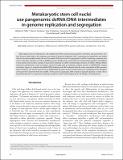| dc.contributor.author | Zukerberg, Lawrence R | |
| dc.contributor.author | Chung, Daniel | |
| dc.contributor.author | Fomina, Janna N | |
| dc.contributor.author | Darroudi, Firouz | |
| dc.contributor.author | Stollar, B David | |
| dc.contributor.author | Gostjeva, Elena V. | |
| dc.contributor.author | Koledova, Vera V | |
| dc.contributor.author | Thilly, William G | |
| dc.date.accessioned | 2014-08-26T15:52:15Z | |
| dc.date.available | 2014-08-26T15:52:15Z | |
| dc.date.issued | 2014-01 | |
| dc.date.submitted | 2013-11 | |
| dc.identifier.issn | 1547-6278 | |
| dc.identifier.issn | 1555-8592 | |
| dc.identifier.uri | http://hdl.handle.net/1721.1/89063 | |
| dc.description.abstract | Bell shaped nuclei of metakaryotic cells double their DNA content during and after symmetric and asymmetric amitotic fissions rather than in the separate, pre-mitotic S-phase of eukaryotic cells. A parsimonious hypothesis was tested that the two anti-parallel strands of each chromatid DNA helix were first segregated as ssDNA-containing complexes into sister nuclei then copied to recreate a dsDNA genome. Metakaryotic nuclei that were treated during amitosis with RNase A and stained with acridine orange or fluorescent antibody to ssDNA revealed large amounts of ssDNA. Without RNase treatment metakaryotic nuclei in amitosis stained strongly with an antibody complex specific to dsRNA/DNA. Images of amitotic figures co-stained with dsRNA/DNA antibody and DAPI indicated that the entire interphase dsDNA genome (B-form helices) was transformed into two dsRNA/DNA genomes (A-form helices) that were segregated in the daughter cell nuclei then retransformed into dsDNA. As this process segregates DNA strands of opposite polarity in sister cells it hypothetically offers a sequential switching mechanism within the diverging stem cell lineages of development. | en_US |
| dc.language.iso | en_US | |
| dc.publisher | Landes Bioscience | en_US |
| dc.relation.isversionof | http://dx.doi.org/10.4161/org.27684 | en_US |
| dc.rights | Creative Commons Attribution-NonCommercial 3.0 Unported License | en_US |
| dc.rights.uri | http://creativecommons.org/licenses/by-nc/3.0/ | en_US |
| dc.source | Organogenesis | en_US |
| dc.title | Metakaryotic stem cell nuclei use pangenomic dsRNA/DNA intermediates in genome replication and segregation | en_US |
| dc.type | Article | en_US |
| dc.identifier.citation | Thilly, William G, Elena V Gostjeva, Vera V Koledova, Lawrence R Zukerberg, Daniel Chung, Janna N Fomina, Firouz Darroudi, and B David Stollar. “Metakaryotic Stem Cell Nuclei Use Pangenomic dsRNA/DNA Intermediates in Genome Replication and Segregation.” Organogenesis 10, no. 1 (January 1, 2014). © 2014 Landes Bioscience | en_US |
| dc.contributor.department | Massachusetts Institute of Technology. Department of Biological Engineering | en_US |
| dc.contributor.department | Massachusetts Institute of Technology. Department of Biology | en_US |
| dc.contributor.mitauthor | Thilly, William G. | en_US |
| dc.contributor.mitauthor | Gostjeva, Elena V. | en_US |
| dc.contributor.mitauthor | Koledova, Vera V. | en_US |
| dc.relation.journal | Organogenesis | en_US |
| dc.eprint.version | Final published version | en_US |
| dc.type.uri | http://purl.org/eprint/type/JournalArticle | en_US |
| eprint.status | http://purl.org/eprint/status/PeerReviewed | en_US |
| dspace.orderedauthors | Thilly, William G; Gostjeva, Elena V; Koledova, Vera V; Zukerberg, Lawrence R; Chung, Daniel; Fomina, Janna N; Darroudi, Firouz; Stollar, B David | en_US |
| dc.identifier.orcid | https://orcid.org/0000-0003-2581-6092 | |
| mit.license | PUBLISHER_CC | en_US |
| mit.metadata.status | Complete | |
